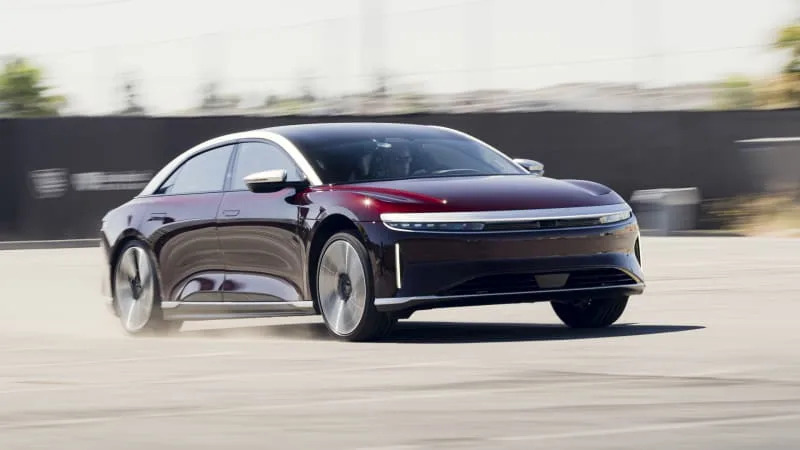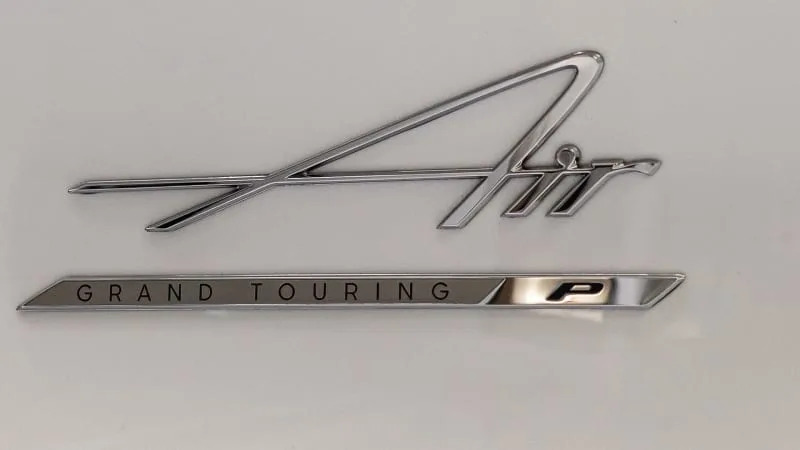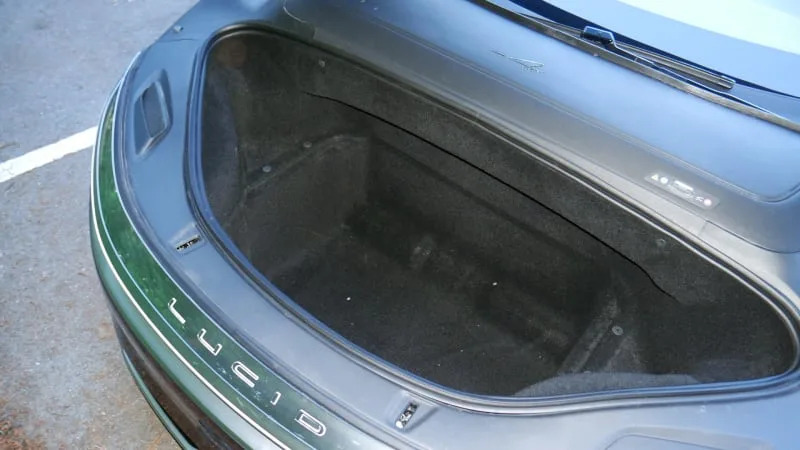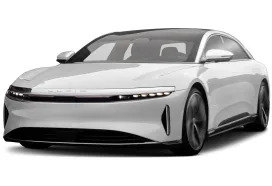MENLO PARK, Calif. – A new car from a new company breeds a certain degree of skepticism. One expects a few rough edges, both literally and figuratively, with a few haphazard choices here and some janky elements there. Something probably won’t work. Something will almost certainly be borrowed from the parts bin of another manufacturer.
The Lucid Air manages to erase that skepticism very quickly. You climb into its driver seat to find an environment that seems perfectly familiar, and not because the switchgear and tech interface were done by some other, familiar company (they were not). There are screens aplenty, but their placement and control layout are largely similar to what you’d find in a traditional button-strewn interior. The screen to the left of the instruments in the 34-inch curved display panel controls things like lights and wipers, while the large touchscreen bridging the console and lower dash does the stuff buttons on the console and lower dash have traditionally done such as climate and drive controls. The screens are also nicely laid out with large, clear icons and easily identified menus. In short, it’s easy to use and has the potential to improve thanks to over-the-air updates. You’d think someone who used to work for Apple was in charge of it. Oh wait, he was and his name is Mike Bell.
There are still some buttons in the cabin, and they look and move with a richness that often gets missed by smaller luxury automakers (see Aston Martin). The rest of the cabin is then a treat for your eyes and fingers, with familiar elements like soft leather, faux suede and open pore wood mixing with novel elements like alpaca wool textile and a two-tone color scheme that sees the front and rear seats in different-color leather. As they say, the devil is in the details, and at least in the cars we sampled, Lucid has nailed them. This is a very expensive car, and the cabin looks and feels the part. The primary complaint? The vast glass windshield that goes up and over the front seats, with another panel in the rear, that don't have shades. They're tinted, fine, but our local star is a rather powerful thing. You shouldn't need to wear a hat in a car.



Like some other electric cars, there’s no start button. There are no buttons on the key fob, either. Approach the car, the door handles pop out, climb in and put your foot on the brake to tell the car you’re ready to go. The transmission selector is an electronic column shifter comparable to Mercedes’ design, but with Lucid’s own piece of hardware.
The car defaults to its “Smooth” drive mode, but will remember which of the two levels of brake regeneration you last used: Standard or High. This is the first electric car I’ve tested where the maximum regenerative brake mode was actually too strong. It was difficult to finesse the throttle enough to avoid a queasy, yo-yo tendency that’s bound to make your passengers (or you) ill. Maybe with practice it’ll be worth the extra electrons recouped, but the Standard setting is still awfully strong, allowing for one-pedal driving and coming to a complete stop by itself. The amount of automatic regenerative braking provided by Standard actually is reduced in the two sport modes, Swift and Sprint, but High remains the same across all modes. Its extreme level of braking is, perhaps paradoxically, more appreciated in the sport modes as it more closely approximates the sort of heavier braking you’d do while hustling along a mountain road.
But enough about slowing down. We start off in the Lucid Air Grand Touring Performance, a new version that closely mirrors the limited-run Dream Edition that produced 1,111 horsepower and hit 60 mph in 2.5 seconds. Lucid turned the dial down ever so slightly to maintain the Dream Edition’s supremacy for the company’s earliest of adopters, but the Performance still manages 1,050 horsepower and 921 pound-feet of torque. Yeah, those numbers are ridiculous. Why the hell was I going on about touchscreens and regenerative braking for so long?
It hits 60 mph in 2.6 seconds, and achieving it couldn’t be easier. First, put the car in Sprint mode, because the car reduces power in the other two modes for efficiency and because, dude, you don’t need 1,050 horses when driving to Whole Foods. You even have to press a “Confirm” button on the touchscreen to acknowledge you’re about to release the beast. With Sprint engaged, you can now engage Launch Control at will. Just put the brake to the floor with your left foot, the throttle to the floor with your right foot, wait a split second for a Launch Control icon to appear in the IP, and then release your left foot. Buh bye. The rest of the experience should really be accompanied by an explosion of zooming stars and a Wookiee.


Now, we also sampled the “standard” Air Grand Touring, which has 819 hp and 885 lb-ft of torque. Its 0-60 time increases to 3 seconds. Oh no. Frankly, the 0-60 times and Launch Control aren’t the best illustration of Lucid’s power-dense and brilliantly packaged motor units. All high-powered EVs benefit from the immediate torque of an electric motor, providing that neck-snap acceleration and punch-to-the-chest feeling. They must also deal with the traction limitations of rubber and pavement, which is why 1,050 hp doesn’t vaporize the doors of less powerful rivals.
As such, it’s the Lucid Air Grand Touring’s 30-50-mph thrust that’s the biggest eye opener. Or rather, you intended to go up to 50 but the car is so blindingly fast that you accidentally ended up at 100 instead. This is a car that can get you into serious trouble with law enforcement. And not just because it’s so fast, but because it utterly scrambles your sense of speed. Something like a Dodge Hellcat or Porsche 911 Turbo S provides ferocious acceleration, but it comes packaged with ferocious noise. The Lucid isn’t entirely quiet – there is some motor whine, and wind still exists – but there’s a high degree of cognitive dissonance nevertheless. And yes, this rolling start acceleration is absolutely greater than a Porsche Taycan Turbo or Audi RS e-Tron GT. A Tesla Model S Plaid? Unfortunately, I haven’t driven one of those.
Now, what about the difference between Grand Touring and the Performance variant? Can you really tell one has 231 more horsepower than the other? Ah, that’s really hard to say. The 30-50-type acceleration seemed to be slightly more vigorous, but without literally going back-to-back on the same stretch of road, it’s just a hunch at this point. Acceleration from a stop? There’s only so much nuance one can detect when your neck is being snapped and your chest compressed.
Basically, you’re probably good to just stick with the Grand Touring, especially since the Performance doesn’t have much of a visual tell that you’ve got the top of the line. The wheel design is different and there’s a little P in 12-point font on the trunk badge. That’s it. The car is also otherwise mechanically the same, including the chassis tuning.


Despite the car’s name and what’s found in many of its key competitors, Lucid does not utilize an air suspension. It has coil springs and adaptive dampers with separately adjustable rebound and compression. It works quite well, achieving a nicely balanced nature between comfort and handling that sure seems like the midpoint between a Mercedes EQS and Porsche Taycan. Even the firmer settings engaged by Swift and Sprint mode won’t beat you up, but do indeed keep the car extremely level in corners. It’s quite neutral, too. Though the power distribution errs to a rear bias in the sporty modes, it’s not particularly noticeable, nor does it venture into playful territory. It doesn’t succumb to understeer, either, nor is there any chassis trickery present such as torque-vectoring differentials or rear-wheel steering. Lucid's director of chassis and vehicle dynamics, David Lickfold, said they considered RWS, but ultimately decided that tuning the rear suspension to compensate for the added complication of different wheel angles just wasn’t worth it. I can’t say the Air felt particularly cumbersome to drive as a result – far from it.
The steering is competent, precise and well-weighted with a rather indifferent amount of feedback. The biggest difference between drive modes is just a little bit more play off center in Smooth mode. This is comparable to the best adjustable steering systems out there, and much like the rest of the car, is indicative of a sophisticated vehicle that feels fully baked as opposed to a startup’s work in progress.

As for the battery, range and recharging, we go into it all in great detail in our deep dive into the Air’s engineering and design. In short, though, the Lucid Air Grand Touring goes further on a charge than everything. With 19-inch wheels, the standard Grand Touring can travel an EPA-estimated 516 miles. Opting for the 21s lowers that to 469 miles, while the Grand Touring Performance manages 446. All are better than the second-place car, the Tesla Model S Long-Range, which the EPA indicates can do 405 miles.
If that’s not enough to alleviate range anxiety, how about the fact that the Air also recharges faster than everything else? You can recoup 300 miles in 21 minutes, or, if you prefer, enjoy a maximum charge rate of 300 kilowatts (second place is the Porsche Taycan at 270 kW). Oh, and the Air’s giant battery and “Wunderbox” onboard charger can power your home or recharge another electric car.
Unfortunately, there’s a drawback to the Grand Touring and its vast range. Lucid did not originally intend for the Air to travel as far as it does on a charge, because it originally had four fewer battery packs that left a rather conspicuous gap in its skateboard-like, battery-filled platform. This gap was needed to provide a sufficiently deep backseat footwell, which you’ll still get in the lower Air Pure and Touring trim levels. When Lucid decided to shoot for the moon and “kill range anxiety,” according to chief engineer Erik Bach, the gap was filled with those four extra packs. This raised the floor, which leaves backseat occupants’ feet awfully close to the same level as their butts. It’s like sitting in an SUV’s third row, albeit with the front seats ahead miles away. In short, you really have to decide how much all that extra range (the Pure and Touring are estimated to provide 406 miles) and power (the Pure provides 480 hp, the Touring 620 hp) you really need given the backseat sacrifice.



Cargo is the same regardless of model, and it’s certainly distinctive. Lifting the huge clamshell trunk lid basically removes the back end of the car, revealing a wide, slot-like trunk. It doesn’t look all that big, but there’s a sizable under-floor compartment big enough for a medium-sized roller bag. The specs say there’s 22.1 cubic feet, but considering the weird shape, it’s less useful than that number makes it seem. Then there’s the frunk, which, at 10 cubic feet, is larger than what you’d find in the Model S, Taycan and EQS (which doesn’t have one at all). It too is a notably wide space with a sizable under-floor area that’s actually bigger than the one at the rear.
Pricing for the Lucid Air will eventually start at $87,400 for the most basic single-motor, Pure trim level. Amongst other missing features, it’s the only Air with a single motor option (dual motors add $5,500) and a single interior choice (versus four California-themed schemes). The Touring trim level, which is standard dual-motor and includes an interior largely analogous to the Grand Tourings’, will start at $107,400. All of the future tense above is indicative of the fact that deliveries aren’t set to begin until the fourth quarter of this year. By contrast, the Grand Tourings have already started to arrive from Lucid’s factory in Arizona. The standard Grand Touring starts at $154,000, while the Performance ups the ante to $179,000.
So yeah, these are not cheap cars. Indeed, that’s an understatement considering that a Mercedes EQS, Tesla Model S and most versions of the Porsche Taycan cost considerably less than the cars we tested in Silicon Valley. That should raise some eyebrows for a car made by a company nobody’s heard of, but once you sit in the car and drive it, it just doesn’t seem that nutty. If its first car is any indication, Lucid sure seems like the real deal.




























































Sign in to post
Please sign in to leave a comment.
Continue